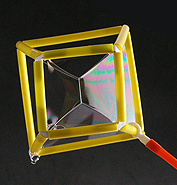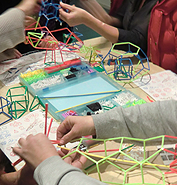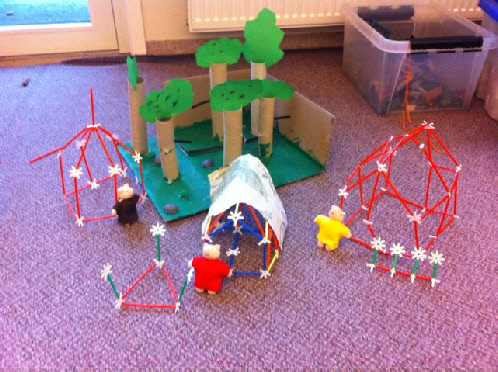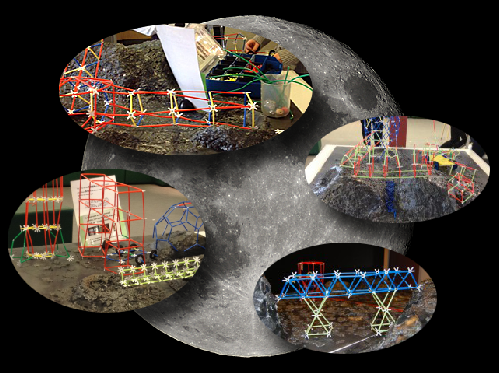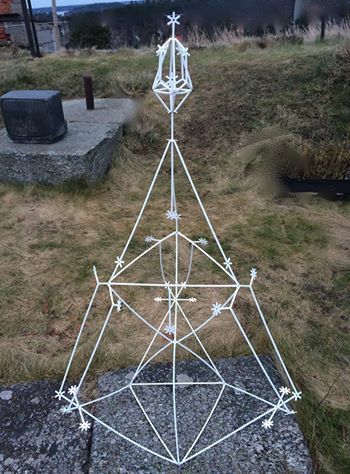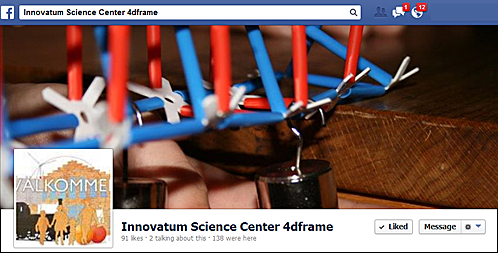
4DFrame in action
Whether it is for schools, museums, science centers, even for in-
The following are examples of some of the various ways that 4DFrame has been used; perhaps one day you too will find one of your very own. We’d then be happy to hear from you; tell us or send us a picture. Good Luck!
”Capturing air with 4DFrame”
Swedish artist and educator Eva Tuvhav Gullberg has recently begun to experiment
with 4DFrame, both as an artistic medium, but also one to help bring out the creativity
of younger school children. Nordic4DFrame delivered her order of materials to her
ateljé – she happens to live in the same island town – and before the end of the
day had received the following photo and her reaction to working with it. “Beautiful—an
exciting new material,” wrote Eva. “What is possible to do with it? 4DFrame is really
a material mainly used for teaching mathematics, geometry, physics, engineering,
etc. My challenge is how to sculpt, shape it as an image-
“It has been really interesting to see what Eva came up with in such a short time, and how elegant and graceful it is,” says Tom Callen, Nordic4DFrame’s Operations Manager. “Often when both students and adults create something out of their imagination, they make something that is familiar along the lines of being a machine, or is rooted in a familiar object. Eva’s reaction to it is not like this at all, but is pure fantasy. One thing I particularly like is that it has no sense of scale. If there was nothing in the background it could be knee high, or as tall as the Eiffel Tower.”
Why not challenge yourself and your students, and do as Eva did: try and capture some air of your own with 4DFrame!

Exploring technology and the future with 4DFrame
The last astronauts walked on the Moon’s surface in December 1972, but that hasn’t stopped school classes visiting Umeå’s Umevatoriet science centre from thinking about what it would be like to return, and build a moonbase there.
A challenge in technology aimed at grades 2 to 9, students first learn about the
history of technology, and then use 4DFrame building materials to make bridges, moon
rovers, and other useful constructions on large three-
The students also visit Umevatoriet’s digital planetarium to learn more about the Moon, such as where the six different lunar landings between 1969 and 1972 took place. Will humans ever return to the Moon? Only our imaginations limit us in what we can do! (Pictures of Moonbase Umega from Umevatoriet, montage by Nordic4DFrame)
"Little pig, little pig, let me come in."
"No, no, not by the hair on my chinny chin chin."
"Then I'll huff, and I'll puff, and I'll blow your house in."
Something new that has recently become popular with children in Sweden using 4DFrame
is to construct three-
This is but another example of how children’s imaginations can be stimulated through
the use of 4DFrame materials. Once they have decided what story they want to show,
how do they actually go about turning the main points of the text into a three-
Innovatum Science Center, Trollhättan, Sweden
Innovatum Science Center is located on the west coast of Sweden in the city of Trollhättan,
about 70 kilometers north-
Link to Innovatum Science Center on Facebook
©2013-
Grönviksvägen 6, 185 41 Vaxholm, Sweden
